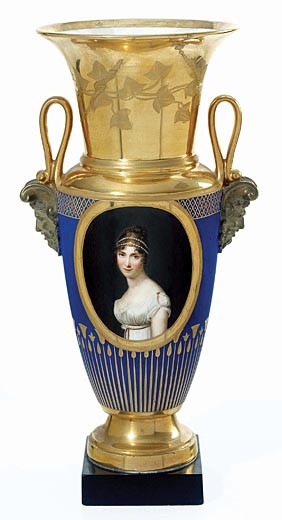Clearly modelled on the form of an antique amphora, this elegant vase reveals a wealth of different decorative forms and techniques. The gilt neck and foot, decorated with vegetation motifs in burnished gold, are in stark contrast to the belly of the base with its medallion portrait of Queen Hortense to the front and her crowned cipher to the back, both set on delicate blue background. On either side, handles grow out of two faun heads done in simulated partina-ed bronze. The base is made of black marble. The provenance is given by the label stuck to the back of the base bearing indication “MANUFACTURE / de S.M. l'Imp. et Reine. / P.L. DAGOTY.”. This style is unusual in that the Dagoty title normally referred to Josephine only as empress and not also as queen (of Italy).
The Dagoty manufactory in Rue de Chevreuse in the Montparnasse quarter of Paris was founded in 1800 by Pierre-Louis Dagoty (1771-1840). At some unknown date, but definitely before 1807, he received the patronage of the empress Josephine. She was not however to be a very good customer since in the period from the beginning of the Empire until the divorce in 1809 she ordered goods worth only 10,333 F, this compared to 12,964 F spent at the Dihl manufactory, of which she not officially patron. On her death in 1814 she only owed Dagoty 2,659 F whilst Dihl had debts outstanding from her of 6,804 F. Indeed, it was from Dihl that she was to order her sumptuous “tableaux” service. Dagoty's porcelains were nevertheless renowned for their quality of their gold and the elegance of the forms; and it was in the Dagoty shop in Boulevard Montmartre that the tongue-in-cheek guide to Paris written by “Hermitte de la Chaussée d'Antin” (Etienne Jouy) noted that you could buy a «hundred-louis vases destined to receive a fifteen-sous anemone».
King Louis had certain Dagoty pieces brought to Holland in 1808 in order to help Dutch porcelain makers. It is therefore logical that he would place an order for vases decorated with portraits of his wife, Queen Hortense. This copy comes from one of Hortense's cousins, Joséphine-Marie Chamans de Lavalette (1802-1866) Baronne de Forget, whose mother's maiden name was Emilie de Beauharnais. Another, smaller example (with slight differences) is held in the Napoleonmuseum d'Arenenberg in Switzerland.
Bernard Chevallier (tr. H.D.W.)
Conservateur général du patrimoine (emeritus)
September 2006
Vase with portrait of Queen Hortense
Artist(s) : DAGOTY (manufactory)

- Date :
- circa 1806-1810
- Technique :
- hard porcelain, black marble
- Dimensions :
- H = 29.8 cm
- Place held :
- Paris, Fondation Napoléon, donation Lapeyre

